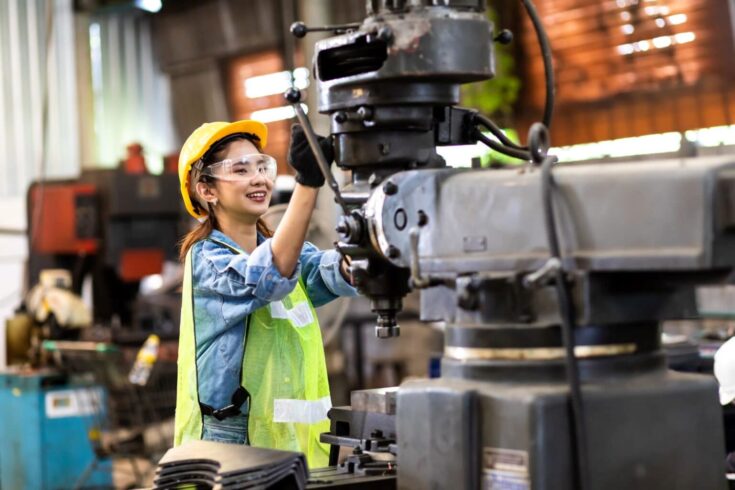In case you missed it, Innovate UK recently published its materials and manufacturing vision for 2050. Taking a systems approach to explore areas from clean energy and future skills to resilient supply chains and proactive regulations and policy.
The document sets out the actions needed to make the UK a world-class destination of choice for advanced low-carbon manufacturing. It makes clear that the international competitiveness of UK manufacturing hinges on three strategic imperatives:
- to be net zero and resource efficient
- resilient and responsive
- technologically advanced and digital
Delivering these imperatives together yields the opportunity for an increase in targeted greenshoring. In other words, greenshoring aims to make the UK a global leader in low-carbon manufacturing, building supply chains and improving UK competitiveness and capability.
Although still a relatively new phenomenon, greenshoring will play an ever-increasingly important role in helping turn the manufacturing vision into reality over the next 30 years, creating significant economic, environmental and societal opportunities for the UK along the way.
Greenshoring explained – is it just another buzzword?
For decades, the standard business practice has been to offshore manufacturing goods to less-developed, lower-wage countries as cheaply as possible. This offshoring of production has helped greatly in making goods more affordable and accessible to the mass market, but recent events have shown that it is not without risk.
During the COVID-19 pandemic and the EU transition, long interconnected, just-in-time supply chains were seen to be vulnerable to disruption. To improve their resilience, many manufacturers instead sought to localise their suppliers though near-shoring and reshoring.
The war in Ukraine has also highlighted geopolitical risks, and in response, supply chains are being switched to other countries to be safeguarded.
In both these examples, supply chains are being reconfigured in response to threats.
Greener supply chains for a low carbon economy
Arguably the greatest threat to our way of life is climate change, and industrial production accounts for around 16% of the UK’s direct carbon emissions. When looking at consumption emissions – carbon embodied in all the goods and services – that figure is estimated to be 43%.
This model of low-cost offshore production is now being understood to come at too high a price in terms of environmental impact. Due to higher-carbon intensity factory processes and emissions from long-distance transport. The growing urgency of shifting to a low-carbon economy means more and more companies are seeking to develop greener supply chains.
So greenshoring isn’t a buzzword it is actually a huge opportunity for UK manufacturing. It represents a shift in focus from low-cost to sustainable manufacturing and dependable, resilient supply chains. As more companies make commitments to achieve net zero, greenshoring will become a key part of the manufacturing sector’s sustainable transformation and help to address security of supply.
Creating new standards: what gets measured is what gets done
To make this happen, more consistency and transparency around standards is needed to make it easier for manufacturers to select sustainable suppliers. The momentum of demand for net zero is gathering pace, and clear standards and transparent carbon accounting can unlock market pull for low-carbon supply chains and reward those who decarbonise.
The UK can take a lead on the development and adoption of these standards. Along with decarbonisation of infrastructure and technologies making the UK a global greenshoring destination and a world leader in sustainable manufacturing.
The High Value Manufacturing (HVM) Catapult is leading on this with two projects that aim to consider embodied emissions for UK manufacturing supply chains:
- ‘Embodied Emissions’, sets out to understand the current carbon accounting tools and standards that exist, as well as standardise the process with which the HVMC centres complete carbon accounting. This project will allow manufacturers to know that if they approach a centre for help understanding embodied emissions, they are getting cutting-edge and consistent support.
- ‘Carbon Accounting’, sponsored by Innovate UK, seeks to standardise the approach to carbon accounting for UK manufacturers. The project is looking at where different tools such as hybrid accounting methods and specific life-cycle assessment tools fit together to accurately address accounting for all scopes of emissions in a supply chain with a focus on scope three emissions.
Laying the foundations to create a global greenshoring destination
Greenshoring will be vital in reducing the environmental impact of manufacturing in the UK, making it a more attractive destination for manufacturers, and improving the UK’s economic competitiveness.
Within the Made Smarter Innovation programme, 12 Sustainable Smart Factory collaborative research and development projects have been funded. One of these, led by supply chain technology developer SupplyVue explicitly aims to make carbon a central tenant of supply chain management.
Using £1.5 million funding from the Made Smarter Innovation challenge, it is working with industry, technology providers and academic partners to develop a new digital platform, CarbonVue. The platform will provide visibility of carbon throughout a supply chain, enabling integrated real-time carbon and productivity management.
The project builds on SupplyVue’s technology, which builds a digital twin of a supply chain. By modelling different scenarios, businesses can identify opportunities for efficiencies and make more informed decisions about future strategies.
By taking a lead in developing and adopting sustainable manufacturing standards, the UK could become a global greenshoring destination and a world leader in sustainable production.
With the potential market opportunity for UK businesses from net zero estimated to be worth more than £1 trillion in the period 2021 to 2030, greenshoring is a significant opportunity for the UK to build a more sustainable and prosperous future.
For the manufacturing sector in particular, there are a number of funding opportunities to help ensure that they continue to improve their resource efficiency, resilience and responsiveness.
For more information on the support available for your part in the UK’s mission critical transformation to net zero through resource efficiency and the use of advanced digital technology, get in touch with Innovate UK KTN or the High Value Manufacturing Catapult.
The greenshoring opportunity
Katherine Bennett CBE, HVM Catapult CEO, said:
The scale of the greenshoring opportunity is huge and the two motives – financial and sustainable – go hand-in-hand. The first step on that journey is being able to accurately measure reductions in emissions. That is why we want to help the government oversee the implementation of a set of standards that every company can use.
Get that right, and whole regions that can demonstrate their low-carbon supply base will enjoy competitive advantages. If our regions thrive, then we develop an expertise that will be the envy of the world.
We then move from offshoring our manufacturing to exporting our knowledge, advising other countries about how to accelerate their own attempts to meet net zero targets. Solidifying our position as a global leader.
A global leader
Mike Biddle, Executive Director of Net Zero, said:
Innovate UK has an inspiring vision for the UK to be a global leader in low-carbon manufacturing. The work being done by the High Value Manufacturing Catapult is a great example of what’s needed to make this happen.
We are passionate about working together in partnership to ensure that we achieve our net zero goals. So that the UK can make and use the fantastic goods and services that we need for our future.
Further information
You can go to the Catapult website
Connect with Innovate UK on LinkedIn
Follow Innovate UK on Facebook
You can go to the new Innovate UK website
You can go to the Innovate UK EDGE website






